WEEK 8- Engagement Introduction (Flow activity)
Teachers to read and facilitate the following:
PERMAH Element
Engagement
Rationale
Flow is the peak experience of engagement- it is the feeling of being “in the zone”, or “fully immersed in a feeling of energized focus, full involvement, and enjoyment in the process of the activity” (Csikszentmihalyi, 2013). In a flow state, we tend to have intense and focussed concentration, and can often lose track of time. A flow experience causes a cascade of neurochemicals- norepinephrine, dopamine, endorphins, anandamide and oxytocin- to be released into our brain (Kotler, 2015). This is the most potent concoction our brain can develop- a natural high. It makes us feel good. Not only that, these experiences are performance enhancing. Creativity has been shown to increase 500-700% in a flow state. We tend to take in more information faster, link together related ideas more readily, (allowing us to synthesise at a higher level) and also connect different ideas more readily, (which improves our lateral thinking) (Kotler, 2015). There are 3 main conditions that can lead to flow: Clear goals and purpose; Immediate feedback; and a balance of challenge and skills (Csikszentmihalyi, Abuhamdeh, & Nakamura, 2005).
Description of Personal Wellbeing Practice: Thumb Challenge for Flow
(Students to face the teacher. Teacher to demonstrate)
To perform the thumb challenge make a fist with a ‘thumbs up’ on one hand.
With your other hand, point your pointer finger directly at the raised thumb.
Now when I (your teacher) says ‘Switch’ simply reverse the position, with the pointer finger on the opposite hand now pointing at the opposite thumb. When you hear ‘Switch’ you alternate between these two positions. Try improving your speed and coordination at each attempt.
Did you experience a flow state during the activity? Discuss. Was there a clear goal and purpose; Immediate feedback (if you got it right or not); and a balance of challenge and skills?
As a class, brainstorm activities that could encourage a state of flow on the board.
Main message:
"Flow is an optimal state of consciousness where we feel our best and perform our best. It is total absorption in a task and total focus." Steven Kotler, 2015
UPP’s Personal Wellbeing Practices
A Personal Wellbeing Practice (PWP) is an evidenced-based positive psychology intervention, applied in school communities or other educational settings. At UPP, we have tried to make these PWP’s simple, concise and relevant for students and their teachers. The six elements for the Personal Wellbeing Practices are: Positive emotion (P); Engagement (E); Relationships (R); Meaning (M); Accomplishment (A); and, Health (H).
We hope that these evidence-based tools of positive psychology will enhance help people to thrive and live their best life, both within and beyond the school gates.
For more activities like this (and much more), check out THRIVE Online Lesson Modules for Pastoral Care and Wellbeing.
Unleashing Personal Potential

